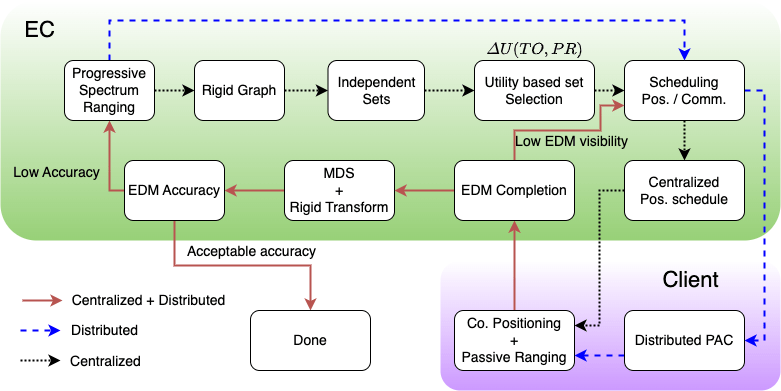Indoor localization is a key technology for the next generation 5G wireless systems (both WiFi and cellular) to cater to the needs of interactive, immersive, and robot-human applications. Such applications require not only sub-meter localization accuracy but also highly demanded communication throughput. The existing positioning standards require a client to take measurements to multiple base stations (BS)s to determine its location (as shown in Fig. 1a). This makes the networks challenging to provide such wide coverage, particularly in higher frequency (mmWave) networks, and also makes it hard to scale up. Besides, the dependence on a densely deployed infrastructure for accurate positioning and the associated cost, the measurement overhead of an infra-based positioning approach can bring significant degradation to communication performance.
To achieve high accuracy in positioning while catering to the needs of high communication throughput, our research on this path proposes a fundamentally different paradigm of communication-aware collaborative positioning (as shown in Fig. 1b) [1].

Communication-aware Collaborative Positioning:
In this paradigm, the burden of positioning is offloaded to client devices in an intelligent, communication-aware, and collaborative manner. The peer-peer positioning communication would reduce overhead and foster improved spatial reuse to preserve communication performance without compromising positioning accuracy. However, to accomplish this objective, we face three key challenges:
- How to characterize the tradeoff between positioning and communication performance?
- How to realize coexistence in practice for both asynchronous (e.g. WiFi) and synchronous (e.g. LTE/5G NR) access systems through the design of scalable, distributed medium access and radio resource management (RRM) modalities?
- How to go beyond coexistence and leverage positioning information to enhance communication performance when we move to more challenging high-frequency mmWave systems?
To cope with the challenges and build an effective system, we propose Communication-aware Collaborative Positioning (CO2P). CO2P incorporates 3 innovative components (as shown in Fig. 2) that intelligently conduct peer-peer positioning. That is (i) Progressive spectral ranging: CO2P maximizes the number of non-interfering peer-peer measurements which can be scheduled simultaneously by employing the largest bandwidth channel for high accuracy and estimate if a longer distance is needed by using lower bandwidth. (ii) Rigidity-aware ranging: CO2P increases the accuracy of the filled-in ranges by prioritizing ranges that establish a tri-lateration ordering of the clients. (iii) Passive ranging: CO2P intelligently enlarges the number of measurements by letting nodes overhear measurements between another pair of clients to infer their own ranges. Additionally, CO2P provides detailed designs incorporating with the components mentioned above for two different wireless networks i.e. synchronized networks such as cellular networks and synchronized networks such as WiFi.

We also implement simulation environments with NS3 and the simulation shows promising results that prove the proposed CO2P effectively offloads the positioning burden from base stations to clients and improves the communication performance without sacrificing positioning accuracy.
Key results:

